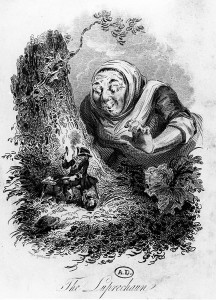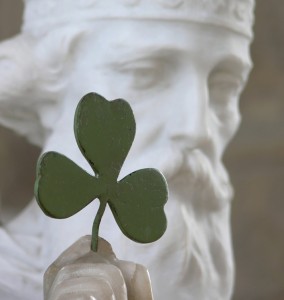Luck of the Irish
Thursday, March 17th, 2022
A St. Patrick’s Day parade marches up Fifth Avenue in New York City. Celebrated on March 17, St. Patrick’s Day is the feast day of Saint Patrick, the patron saint of Ireland.
Credit: © Rafael Macia, Photo Researchers
Luck, chance, and good fortune are all terms for a charmed life. On Saint Patrick’s Day, celebrated on March 17th, you might hear a common phrase proclaiming the “luck of the Irish.” Surprisingly, the favorable phrase came from Americans looking for a gold rush in the 1800’s. Many participants in the California gold rush who gained riches were Irish miners from the United States and Ireland. The phrase has gone from derogatory, referencing ‘dumb luck,’ to positive over the decades.
Many people turn to folklore for explanation of the countrymen’s luck. Finding a mythical leprechaun or the pot of gold at the end of the rainbow would be lucky for anyone. A leprechaun, << LEHP ruh kawn, >> is a solitary fairy of Irish folklore typically depicted as a cheerful, elderly man.

According to tradition, a person who captures a leprechaun can force him to give up his treasure. This engraving shows a woman sneaking up to capture a leprechaun as he repairs a shoe by a tree.
Credit: (c. 1800-50) engraving by George Cruikshank, Bibliotheque des Arts Decoratifs (Bridgeman Art Library)
According to folklore, leprechauns are clever and greedy. They keep a pot of gold hidden at the end of a rainbow. A person who captures a leprechaun can force the leprechaun to give up his treasure. But a leprechaun usually tricks his captor into looking away and thus escapes. A leprechaun may also grant a person three wishes in exchange for the gold. The leprechaun then tricks the person into wasting the wishes.
Leprechauns often perform good deeds or produce goods for people. In many folk tales, they are cobblers who make and repair shoes. An object made by a leprechaun is thought to bring good luck to anyone who possesses it.
Common good luck charms include a horseshoe, a four-leaf clover, a sprig of heather, and a rabbit‘s foot. Charms are objects thought to have magical power that can be transmitted to those who carry them. They are used to attract good luck and to ward off evil. A four-leaf clover is similar to a shamrock, or three-leaf clover, common in Ireland. Only about 1 in 5,000 clovers have four leaves, so finding a four-leaf clover is a sign of good luck. According to legend, Saint Patrick used a shamrock to explain the idea of the Trinity to the Irish.
In Ireland, St. Patrick’s Day is primarily a religious holiday. It also is celebrated outside of Ireland in cities with a large number of people of Irish descent. In the United States, St. Patrick’s Day is primarily a secular (nonreligious) holiday.
March 17th is the feast day of Saint Patrick, the patron saint of Ireland. Saint Patrick was a missionary to Ireland in the A.D. 400′s. He converted the Irish to Christianity. People honor Saint Patrick by attending special religious services. They also enjoy family and community gatherings. They celebrate by wearing shamrocks. In the United States, many people wear green clothing. They also hold parties and march in parades. The first St. Patrick’s Day celebration in what is now the United States was held in Boston, Massachusetts, in 1737. Today, more than 100 U.S. cities hold parades. The St. Patrick’s Day parade in New York City, New York, is the largest.




